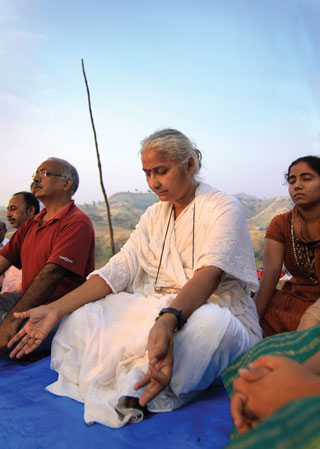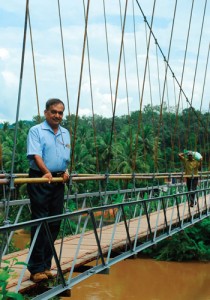An indefatigable spirit, Medha Patkar sits down for a two-hour interview well past midnight. It has been a day of relentless meetings as people from across the country gather to reflect on the Narmada Bachao Andolan’s 25 year struggle. The focus has shifted she says as she settles down, and talks of the journey from Narmada Bachao to Desh Bachao. She frequently interrupts herself to ask about certain people and their presence through the day. Excerpts from an interview with Sanjana Chappalli:
Do you even remember your first year in the valley? What were the initial challenges that you encountered?
When we started working on this issue, there was a total vacuum on this issue of how to deal with the development projects and displacement. Also, not too many people understood the link between the two. The process of sanctioning the project itself went on for a long time and the agitation on the ground had already started, with several arrests having taken place. But despite this there was no clear idea about the enormity of the project and its impact despite a policy having come into place. Our first challenge then really was to identify the issue, present it back to the people and then form the linkages between the project and displacement. That was a real challenge in many ways. Travelling to the hamlets was a task in itself, but additionally when we hit the ground we found several hamlets that did not exist on paper! And there was no concept of land rights at all. In any one hamlet, we found possibly four or five families with proper land titles. So when we started really, neither the land nor the people were on record!
 Living on a prayer Patkar says the media attention on the NBA has waned
Living on a prayer Patkar says the media attention on the NBA has wanedPhotos: Shailendra Pandey
And with such immediate concerns such as lack of records and land titles, did you ever feel that you had to address these issues first, earn the confidence of the Adivasis before introducing the idea of a project that was too huge for their imagination?
To be honest, my entire background has always been in community organising. I started early; by the time I was in seventh standard, I was working in the slums on weekends. All my vacations were spent with them. I was part of the Rashtra Seva Dal, a socialist youth group which as not involved in any charity related project but rather focussed on community mobilisation as well as imparting the ideology of the group to the slum dwellers. I think this helped me immensely in the valley early on, so community mobilisation has never been a challenge for me. There was a lot of learning to do initially though. In those days, I was always accompanied by someone but my team members changed constantly. There were a lot of papers to read and understand – on land acquisition, forest rights, etc. That first year went by very quickly and even as we delved into reports, the World Bank had arrived on our doorstep. We had received a lot of the documents from Gujarat since I used to work there earlier. Accessing those documents proved to be of immense help.
It was on the basis of these documents that we drafted the 36 demands in Manibeli, Maharashtra in 1987. The charter of 36 demands was used in our discussions with the World Bank as well – the first time we took the demands outside the country. We made a series of presentations to the organisations that worked with donor countries over the policies and projects in the borrower countries. This was the first phase of the struggle really and it was a phase I enjoyed very much since it involved a close reading of several documents.
I was always very good at engaging with detailed reports and turning out comprehensive analyses to the extent that in college, I was in constant dilemma about opting for the arts or science stream – I could have excelled in either. Additionally, it involved travelling to the interior areas, something that I had enjoyed from the time immensely. Despite all this, I must say that I had never worked in any place that was as interior as the hamlets here. We had to walk 20 km to get to a village and then 20 km back out the same way to go elsewhere. Frequently I was up at 3 am to catch the 5.15 am bus out of the village. It was a very intense phase of the struggle – on the one hand I was reading a stack of documents and on the other travelling to interior hamlets to mobilise people. I remember the first song that I wrote in the two-and-a-half hour bus ride from Hapeshwar to Kadipani in Gujarat was based on this concept. In fact, all the songs that I have written so far have been in buses and vehicles I travelled in across the valley.
Today, the people are raising the issues and NBA’s role is limited to that of a catalyst
What is the organisation structure of the Andolan, if there is one?
In the second phase of the struggle, the organization structure of the Andolan began to evolve. It had to evolve very naturally and I remember there was a lot of debate about the name of the Andolan itself. In Maharashtra, even before the Andolan there was a Narmada Dharangrast Samiti that existed. But we felt that we had to evolve an organisation focus that would not only bring in the environment focus but that would be equally focussed on the people as well. We decided then that this would be a people’s movement and not an NGO. Also at that time there were several people who asked us why we took an anti-dam position and not focus on the rehabilitation aspects. There were several comments to this tune – we haven’t maintained a historical record of these meetings, our activist Sanjay Sangavai used to do that to some extent when he was alive – but it is absolutely true that people have decided on every action, every step of the way.
Today, they are the ones who are raising the issues and our role is limited to that of a catalyst one. People have their own way of understanding things – constantly they sit up and ask how the State can take decisions without asking them. We have fancy terms such as consultation with the gram sabhas, environmental impacts. On the ground, the use of these terms seem farcical, because if you ask people about these terms, they are bound to be clueless. But the fact is that they understand the concepts even if they do not know the terms. Frequently, they would describe experiences where they lost hours and days waiting in government offices for information. That’s when we decided on the people’s right to information about the project. We demanded that officers have to come to our villages, and explain in our language the impact that this project would have on our lives. That the government cannot sit in Mumbai, Gandhinagar, Delhi and take decisions that affecting our lives. Looking back I wonder if we realised then that within the communication channels between the State, the omnipotent and the people the project affected had been challenged. Even the current multiple front, multiple plank strategy of the National Alliance of People’s Movements had its seeds in the days back then.
Did the Supreme Court judgement in October 2000 (the Court dismissed the NBA’s petition and allowed for the construction of the SSP to proceed with stage wise rehabilitation) necessitate a shift in the focus of the struggle – from anti-displacement to rehabilitation? Do you see this as a dilution of NBA politics?
I think it is also important to understand that displacement is the primary issue on hand, not rehabilitation. We have to ask questions about the kind of displacement, the nature of it, the extent and whether it is justifiable and acceptable to the people who are getting displaced. It is only after understanding this that the question of rehabilitation comes into the picture.
If you had to pick one seminal success that you remember in the 25 years of struggle, what would it be?
There have been several; but getting the World Bank to withdraw its funding was a huge success for the struggle. The World Bank had actually sanctioned funds without accepting the rationale, without the project studies having been completed. From that point on to getting them to withdraw the 5 percent was an important struggle. In several World Bank reports now, they refer to the lessons learnt from the Narmada funding project. The fact is that they have stopped funding projects directly but instead fund sectorally across states. That way it is difficult to understand how much money they have paid for which project.
There was a point when the support system for the NBA was very strong among the middle classes in cities across India and outside. There would be a constant flood of volunteers to the vlley. I don’t see as many people now. Has the support base among these sections decreased?
I would say that the support base has increased but just that the media attention on the kind of support has decreased. The media constantly wants ‘action’ in the valley to train their attention on events here. If no such action takes place, there is an assumption that nothing is happening. And the urban supporters depend on the media. Despite this, I would say support base has increased since it is no longer the NBA alone. We are now talking about a range of social movements which are part of the National Alliance of People’s Movements.
Beyond the constant refrain of alliances between Dalits, Adivasis and oppressed communities, what is the larger agenda that the National Alliance of People’s Movements has sketched for itself?
We have written out separate agendas for various aspects. There is an inherent interconnectedness that needs to surface.
But does a national alliance of such character take on board the subjective realities of the local movements?
There is no concept of not taking this on board. It is the people themselves who decide everything at every stage. And we are only talking of uniting our forces to fight against an unjust system.
—
This article was originally published in Tehelka, a leading independent news magazine in India, known for its investigative journalism.



